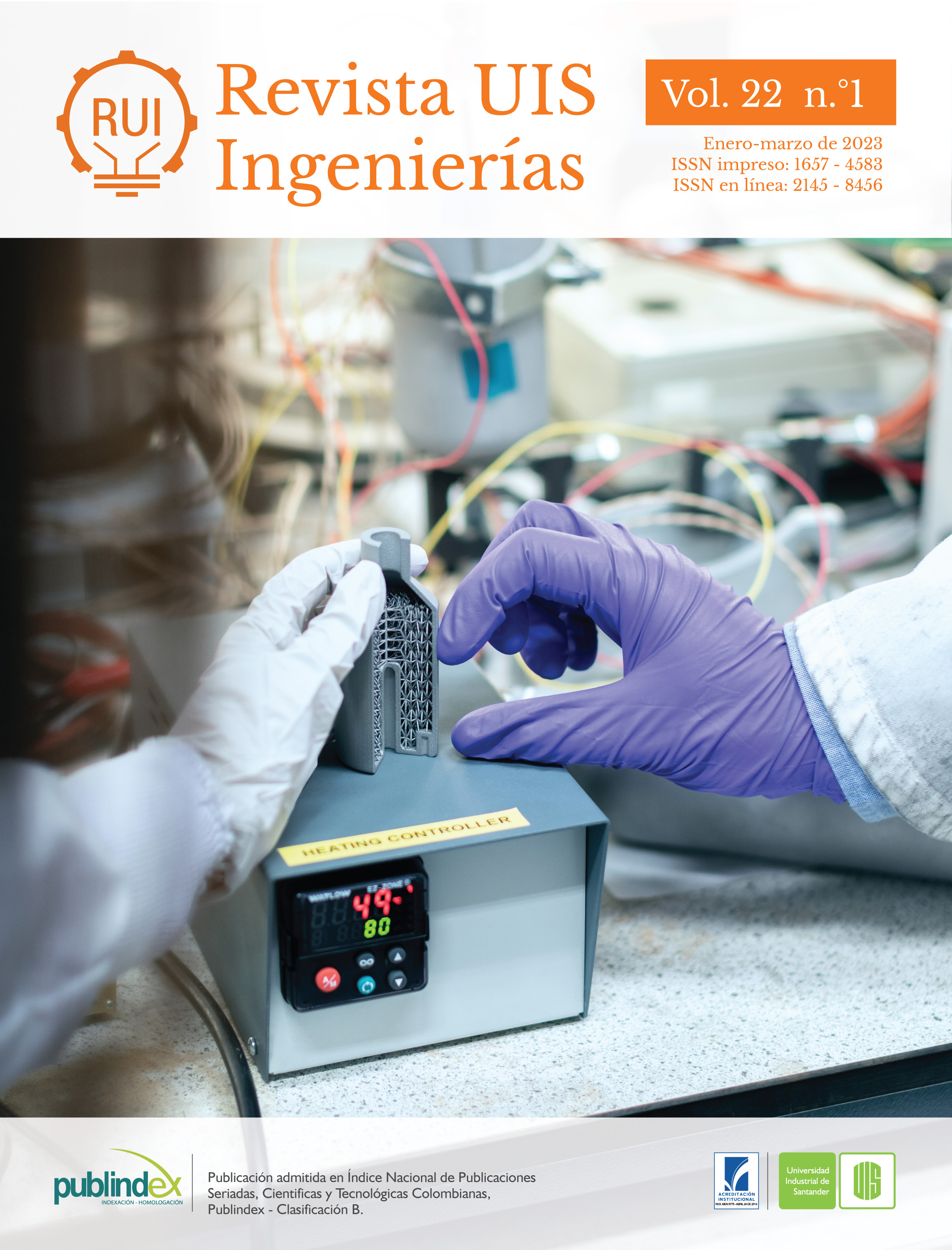Experimental analysis of liquid-liquid flow in a horizontal tube using artificial neural networks
Published 2023-01-24
Keywords
- Oil-water flow,
- superficial velocity,
- holdup,
- artificial neural network
How to Cite
Copyright (c) 2023 Revista UIS Ingenierías

This work is licensed under a Creative Commons Attribution-NoDerivatives 4.0 International License.
Abstract
The objective of this work was the application of an artificial neural network in prediction of holdup of two-phase flow (oil-water) in a pipe in horizontal position. To this end, the velocity superficial of water and oil were used as input parameters, meanwhile, the holdups of these two fluids were used as output parameters for the training and testing of the multilayer neural network, the method used was back-propagation. The experimental data (92 data) were taken at LEMI-EESC-USP and were used to develop the artificial neural network model. Finally, it was concluded that the experimental data used in the neural network agreed with the tagsig transfer function with 10 neurons in the hidden layer evaluated from the absolute percentage error of (AAPE= 3,95) and coefficient of determination ( = 0,975).
Downloads
References
- F. K. Suguimoto, “Análise experimental do escoamento líquido-líquido,” tesis doctoral,Universidade Estadual de Campinas, 2016.
- I. N. Silva, D. H. Spatti, R. A. Flauzino, Redes Neurais Artificiais Para Engenharia e Ciências Aplicadas. São Paulo, 2010.
- G. . Wallis, One-Dimensional Two-Phase Flow. McGraw-Hill, 1969.
- Y. Mi, M. Ishii, and L. H. Tsoukalas, “Vertical two-phase flow identification using advanced instrumentation and neural networks,” Nucl. Eng. Des., vol. 184, no. 2–3, pp. 409–420, 1998, doi: https://doi.org/10.1016/S0029-5493(98)00212-X
- Y. Mi, M. Ishii, L. H. Tsoukalas, “Flow regime identification methodology with neural networks and two-phase flow models,” Nucl. Eng. Des., vol. 204, no. 1–3, pp. 87–100, 2001, doi: https://doi.org/10.1016/S0029-5493(00)00325-3
- C. Tan, F. Dong, and M. Wu, “Identification of gas/liquid two-phase flow regime through ERT-based measurement and feature extraction,” Flow Meas. Instrum., vol. 18, no. 5–6, pp. 255–261, 2007, doi: https://doi.org/10.1016/j.flowmeasinst.2007.08.003
- E. S. Rosa, R. M. Salgado, T. Ohishi, N. Mastelari, “Performance comparison of artificial neural networks and expert systems applied to flow pattern identification in vertical ascendant gas-liquid flows,” Int. J. Multiph. Flow, vol. 36, no. 9, pp. 738–754, 2010, doi: https://doi.org/10.1016/j.ijmultiphaseflow.2010.05.001
- R. Banasiak et al., “Study on two-phase flow regime visualization and identification using 3D electrical capacitance tomography and fuzzy-logic classification,” Int. J. Multiph. Flow, vol. 58, pp. 1–14, 2014, doi: https://doi.org/10.1016/j.ijmultiphaseflow.2013.07.003
- H. Shaban, S. Tavoularis, “Identification of flow regime in vertical upward air-water pipe flow using differential pressure signals and elastic maps,” Int. J. Multiph. Flow, vol. 61, pp. 62–72, 2014, doi: https://doi.org/10.1016/j.ijmultiphaseflow.2014.01.009
- H. Shaban, S. Tavoularis, “Measurement of gas and liquid flow rates in two-phase pipe flows by the application of machine learning techniques to differential pressure signals,” Int. J. Multiph. Flow, vol. 67, pp. 106–117, 2014, doi: https://doi.org/10.1016/j.ijmultiphaseflow.2014.08.012
- L. Wang, J. Liu, Y. Yan, X. Wang, T. Wang, “Gas-Liquid Two-Phase Flow Measurement Using Coriolis Flowmeters Incorporating Artificial Neural Network, Support Vector Machine, and Genetic Programming Algorithms,” IEEE Trans. Instrum. Meas., vol. 66, no. 5, pp. 852–868, 2017, doi: https://doi.org/10.1109/TIM.2016.2634630
- A. Van Der Spek, A. Thomas, “Neural-net identification of flow regime with band spectra of flow-generated sound,” SPE Reserv. Eval. Eng., vol. 2, no. 6, pp. 489–498, 1999, doi: https://doi.org/10.2118/59067-PA
- S. Cai, H. Toral, J. Qiu, J. S. Archer, “Neural network based objective flow regime identification in air‐water two phase flow,” Can. J. Chem. Eng., vol. 72, no. 3, pp. 440–445, 1994, doi: https://doi.org/10.1002/cjce.5450720308
- H. Yan, Y. H. Liu, C. T. Liu, “Identification of flow regimes using back-propagation networks trained on simulated data based on a capacitance tomography sensor,” Meas. Sci. Technol., vol. 15, no. 2, pp. 432–436, 2004, doi: https://doi.org/10.1088/0957-0233/15/2/017
- R. Hanus, M. Zych, M. Kusy, M. Jaszczur, L. Petryka, “Identification of liquid-gas flow regime in a pipeline using gamma-ray absorption technique and computational intelligence methods,” Flow Meas. Instrum., vol. 60, no. September 2017, pp. 17–23, 2018, doi: https://doi.org/10.1016/j.flowmeasinst.2018.02.008
- P. Wiedemann, A. Döß, E. Schleicher, U. Hampel, “Fuzzy flow pattern identification in horizontal air-water two-phase flow based on wire-mesh sensor data,” Int. J. Multiph. Flow, vol. 117, pp. 153–162, 2019, doi: https://doi.org/10.1016/j.ijmultiphaseflow.2019.05.004
- L. Zhang and H. Wang, “Identification of oil-gas two-phase flow pattern based on SVM and electrical capacitance tomography technique,” Flow Meas. Instrum., vol. 21, no. 1, pp. 20–24, 2010, doi: https://doi.org/10.1016/j.flowmeasinst.2009.08.006
- M. M. F. Figueiredo, J. L. Goncalves, A. M. V. Nakashima, A. M. F. Fileti, R. D. M. Carvalho, “The use of an ultrasonic technique and neural networks for identification of the flow pattern and measurement of the gas volume fraction in multiphase flows,” Exp. Therm. Fluid Sci., vol. 70, pp. 29–50, 2016, doi: https://doi.org/10.1016/j.expthermflusci.2015.08.010
- M. Meribout, N. Al-Rawahi, A. Al-Naamany, A. Al-Bimani, K. Al-Busaidi, A. Meribout, “Integration of impedance measurements with acoustic measurements for accurate two phase flow metering in case of high water-cut,” Flow Meas. Instrum., vol. 21, no. 1, pp. 8–19, 2010, doi: https://doi.org/10.1016/j.flowmeasinst.2009.09.002
- S. Azizi, M. M. Awad, E. Ahmadloo, “Prediction of water holdup in vertical and inclined oil-water two-phase flow using artificial neural network,” Int. J. Multiph. Flow, vol. 80, pp. 181–187, 2016, doi: https://doi.org/10.1016/j.ijmultiphaseflow.2015.12.010
- T. Sunder Raj, D. P. Chakrabarti, G. Das, “Liquid-liquid stratified flow through horizontal conduits,” Chem. Eng. Technol., vol. 28, no. 8, pp. 899–907, 2005, doi: https://doi.org/10.1002/ceat.200500067
- R. Shirley, D. P. Chakrabarti, G. Das, “Artificial Neural Networks in Liquid-Liquid Two-Phase Flow,” Chem. Eng. Commun., vol. 199, no. 12, pp. 1520–1542, 2012, doi: https://doi.org/10.1080/00986445.2012.682323
- D. P. Chakrabarti, G. Das, S. Ray, “Pressure drop in liquid-liquid two phase horizontal flow: Experiment and prediction,” Chem. Eng. Technol., vol. 28, no. 9, pp. 1003–1009, 2005, doi: https://doi.org/10.1002/ceat.200500143
- Shoham O, Mechanistic Modeling of Gas-Liquid Two-Phase Flow in Pipes. 2006.

